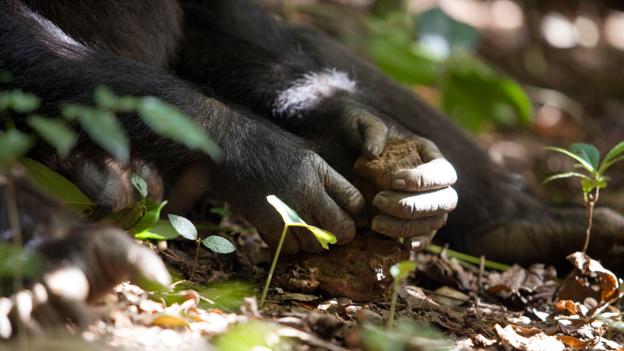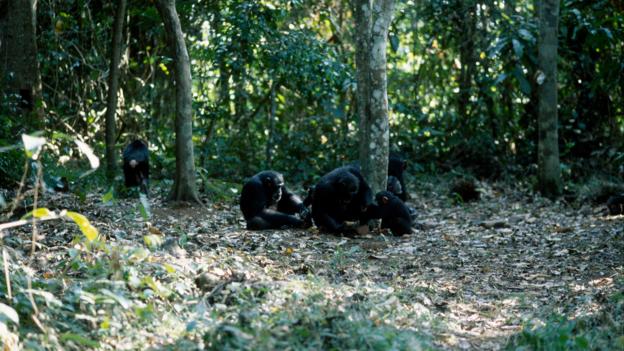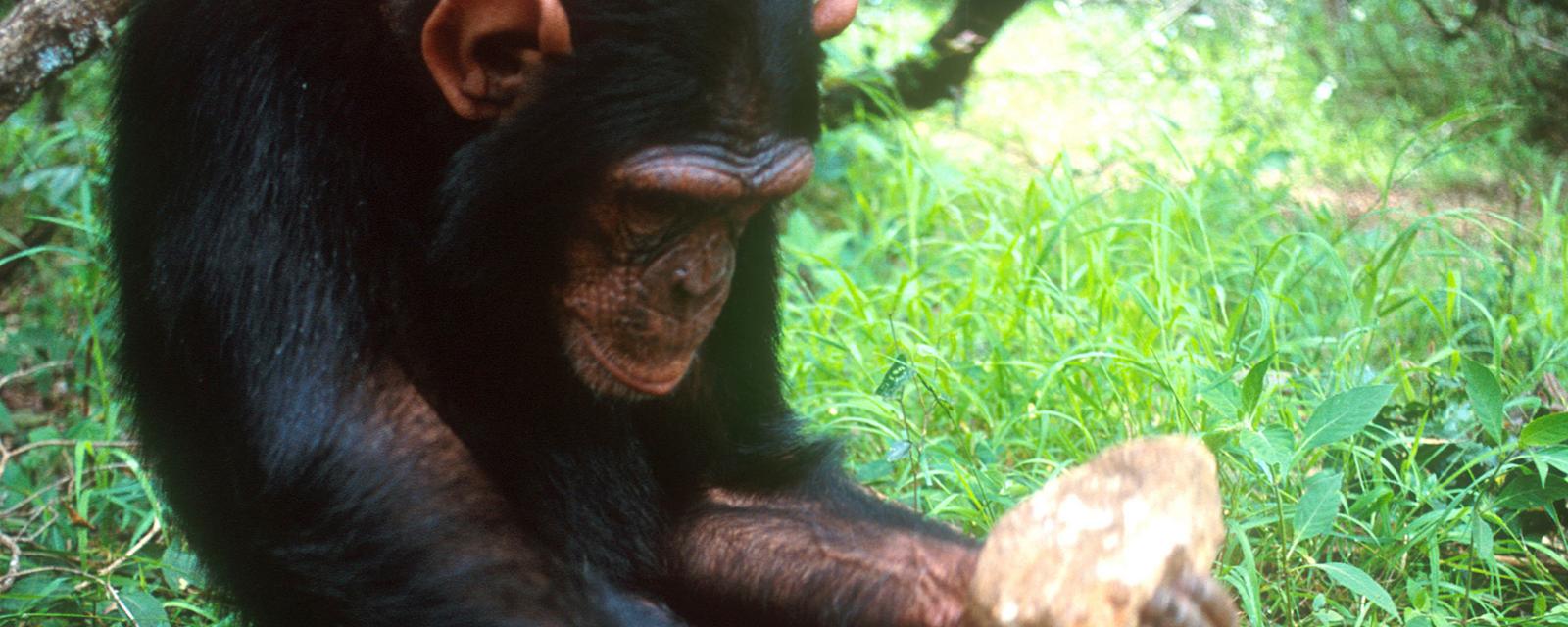Chimpanzees and monkeys have entered the Stone Age
We think of the Stone Age as something that early humans
lived through. But we are not the only species that has invented it
By Colin Barras
It's not the workmanship that makes them special. If anything, a casual observer might struggle to even identify them as ancient tools. It's not their antiquity that's exceptional either: they're only about the same age as the Egyptian pyramids.
What makes these tools noteworthy is that the hands that held them weren't human.
These stone tools were wielded by chimpanzees, capuchins and macaques. The sites where they have been unearthed are the basis of a brand new field of science: primate archaeology.
The tools are crude. A chimpanzee or monkey stone hammer is hardly a work of art to rival the beauty of an ancient human hand axe. But that's not the point. These primates have developed a culture that makes routine use of a stone-based technology. That means they have entered the Stone Age.

New Caledonian crow (Corvus moneduloides) uses tool to
forage (Credit: Roland Seitre/NPL)
A few decades ago, biologists thought humans were the only species that made extensive use of tools.
Not any more. We now know that many mammals, birds, fish and even insects use objects in their environment as tools to make their lives easier.
Many primates use tools too. In 2014, for instance, there were reports of a wild gorilla using a twig to fish ants out of a nest. But primates don't, as a rule, turn stones into tools.
"Orang-utans, bonobos and gorillas have been seen using plant tools but never stone tools," says Michael Haslam at the University of Oxford in the UK, and leader of the Primate Archaeology (Primarch) project.

A chimpanzee uses a stone hammer (Credit: Justine
Evans/NPL)
But it might have to do with the fact that stones are not readily available to species that spend much of their time in and around trees. "Plants are ubiquitous in primate habitats but stones are not," says Haslam.
This means that even if a particularly clever great ape does begin using stone tools, there aren't enough rocks around for that tradition to be aped by others in the group, and passed down through the generations.
However, the chimpanzees of west Africa do seem to have managed to pass their stone-based technology – which they use to crack open nuts – down many generations. We know this because of a landmark study in primate archaeology that was published in 2007.

The dense forests of the Ivory Coast (Credit: André
Quillien/Alamy)
"Primate archaeologists" led by Christophe Boesch at the Max Planck Institute for Evolutionary Anthropology in Leipzig, Germany, set about applying these principles to chimpanzee tools.
In the rainforests of Ivory Coast they excavated an area of the forest floor down to a depth of about 1m, unearthing a 4300-year-old horizon rich in stone artefacts.
Some of those stone artefacts have been worked with a level of precision possessed by humans alone.
But others had marks that suggested they had been used in a cruder way, as pounding tools for cracking open tough nuts: just as chimpanzees in the region use stone tools today.

Chimpanzees have been using stone tools for millennia
(Credit: Bernard Walton/NPL)
For instance, chimpanzees will often deliberately opt for particularly large and heavy stone hammers, between 1kg and 9kg, while humans prefer to use stones that weigh 1kg or less. Many of the 4300-year-old stone tools weighed more than 1kg, suggesting they were used by chimpanzees.
Chimpanzees also use their stone tools to crack open certain types of nuts that humans don't eat. Starch residues on some of the ancient tools came from these nuts.
Together, these findings led to an obvious conclusion: chimpanzees have been using stone tools in the rainforests of Ivory Coast for at least 4300 years.
The chimpanzee Stone Age began at least that early, and maybe even earlier, says Boesch. However, "it is very hard to predict where you would find soil layers that would be old enough to look at earlier periods."
In theory, the chimpanzee Stone Age might have begun very early indeed.

A group of chimpanzees cracking nuts with stones (Credit:
Bernard Walton/NPL)
Haslam says this is unlikely. If that was the case we might reasonably expect all chimpanzees to use stone tools, but only a small number of communities in west Africa do so.
It's more logical to imagine that the chimpanzees of west Africa have developed a stone tool tradition in the time since they split from central and east African chimp communities. Haslam says this happened between 500,000 and 1 million years ago.
It now seems that this west African chimpanzee Stone Age is completely distinct from the human Stone Age.

A bearded capuchin eating a nut cracked using a stone
(Credit: Mary McDonald/NPL)
So do long-tailed macaque monkeys (Macaca fascicularis aurea) in Thailand, according to a study published in May 2015.
Neither species sits particularly near humans in the primate evolutionary tree.
"Capuchins are New World monkeys, separated from us by some 35 million years of evolution," says Haslam. "Even the macaques are separated from us by around 25 million years."
In other words, the Stone Age primates are so widely scattered across the evolutionary tree that they must have each come up with the technology independently. "We have multiple inventions of the same behaviour," says Haslam.

Long-tailed macaques live on islands in Thailand (Credit:
Mark MacEwen/NPL)
"We have now recovered buried stone tools from activity areas of all the stone-tool-using primates," says Haslam.
The capuchins, like the chimpanzees, use their stone tools to crack open nuts, and also to dig for tubers.
"Every time someone has gone to look at wild groups of bearded capuchins in their natural habitat, they've found stone tool use," says Haslam. "This species may be the only one other than humans that has ubiquitous stone artefacts."
By contrast, the macaques live on islands and use their stones to crack open shellfish.
Both species of monkey have apparently passed the tradition down the generations. That means there is a deep history of stone tool use in at least three primates other than humans.
Chimpanzee and monkey stone tools look very primitive. But then again, our ancestors' stone tools were just as primitive too, long ago.

South American capuchin monkeys have learned to use stone
tools (Credit: Dave Watts/NPL)
These "Lomekwian" stone tools were recovered from 3.3-million-year-old deposits. According to the team that found them, they were produced using techniques similar to those used by stone-wielding chimps and monkeys.
This means studying primates that use stone tools could tell us about the nature of early human behaviour. However, drawing conclusions won't be easy: early humans are very different from chimpanzees and monkeys.
Within about 700,000 years of those Lomekwian stone tools, human technology had moved on. First came "Oldowan" tools, including stones that had been deliberately modified to make a sharp edge by "flaking" off small pieces. A million years later, Acheulean hand axes with carefully-shaped cutting edges begin appearing in the archaeological record.
Why did our ancestors learn to make such sophisticated stone tools, and so long ago, while chimps and monkeys never got beyond a Lomekwian-style technology?

Human hands have changed less than chimps' (Credit: Doug
Allan/NPL)
You might think it would be down to evolutionary advances in the anatomy of our hands, perhaps allowing for finer manipulation of objects.
In fact, a July 2015 study by Sergio Almécija of George Washington University in Washington, DC suggests that, if anything, human hands have changed less over the last few million years than chimpanzee hands.
"The ancestor of humans and chimps had hand length proportions more similar, but not equal, to humans than to chimpanzees," says Almécija. "In terms of [digit] length proportions, humans are in fact more primitive than chimps."
If it's not chimpanzees' and monkeys' hands that are holding them back, the problem probably lies in their brains, says Almécija.

A long-tailed macaque cracks cockles with a stone tool
(Credit: Mark MacEwen/NPL)
Humans' larger brains, and our resulting greater smarts, may be what allowed us to make ever better tools. But it's difficult to say exactly why our ancestors' brains began to swell.
One idea, suggested by primatologist Richard Wrangham, also at Harvard, is that our growing brains were fuelled by the development of cooking. "Larger brains require a lot of energy to grow and maintain, and cooking increases the energy available from food relative to a raw diet," says Rosati.
It's not clear when humans first invented cooking. It may have been long after our brains began swelling, which would mean Wrangham's idea is probably wrong.
But if he is correct, it suggests that a 2015 study by Rosati and her Harvard colleague Felix Warneken is very significant. Chimps might not have learned to control fire, but Rosati and Warneken found that they have enough smarts to appreciate the benefits of cooking.

A black-striped capuchin eating a cracked nut (Credit:
Mary McDonald/NPL)
The chimps were far more likely to put raw potato chips into this "oven" than into a second container that returned the food still raw.
What's more, when the chimps were given wood chips as well as raw potato chips, they generally didn't bother placing the wood into the "oven". That suggests they didn't see it simply as a cooked food dispenser, but understood that it would only cook edible things.
The chimps were even prepared to carry raw food from a remote location to the "oven" to have it cooked. This reflects the way our ancestors must have begun transporting food to the fireside millions of years ago.

Control of fire was a major step in human history
(Credit: Ariadne Van Zandbergen/Alamy)
It's possible that chimpanzees – and macaques and capuchins – haven't yet reached the limits of their technological capabilities, says Haslam.
But it's not clear whether they will have the opportunity to advance their Stone Age technology.
"We are shrinking their populations dramatically through habitat destruction and hunting," says Haslam. "Smaller populations cannot spread and sustain complex technologies as well as larger groups."
In other words, chimps and monkeys might have the capacity to make much more sophisticated stone tools, but they may never get the chance to achieve that potential: all because of another group of primates that became master stone tool manufacturers.
For more information about animal intelligence see http://nexusilluminati.blogspot.com/search/label/animal%20intelligence
- Scroll down
through ‘Older Posts’ at the end of each section
Hope you like this
not for profit site -
It takes hours of work every day by
a genuinely incapacitated invalid to maintain, write, edit, research,
illustrate and publish this website from a tiny cabin in a remote forest
Like what we do? Please give anything
you can -
Contribute any amount and receive at
least one New Illuminati eBook!
(You can use a card
securely if you don’t use Paypal)
Please click below -
Spare Bitcoin
change?
For further enlightening
information enter a word or phrase into the random synchronistic search box @
the top left of http://nexusilluminati.blogspot.com
And see
New Illuminati – http://nexusilluminati.blogspot.com
New Illuminati on Facebook - https://www.facebook.com/the.new.illuminati
New Illuminati Youtube Channel - https://www.youtube.com/user/newilluminati/playlists
New Illuminati’s OWN Youtube Videos
-
New Illuminati on Google+ @ For
New Illuminati posts - https://plus.google.com/u/0/+RamAyana0/posts
New Illuminati on Twitter @ www.twitter.com/new_illuminati
New Illuminations –Art(icles) by
R. Ayana @ http://newilluminations.blogspot.com
The Her(m)etic Hermit - http://hermetic.blog.com
DISGRUNTLED SITE ADMINS PLEASE NOTE –
We provide
a live link to your original material on your site (and links via social
networking services) - which raises your ranking on search engines and helps
spread your info further!
This site
is published under Creative Commons (Attribution) CopyRIGHT (unless an
individual article or other item is declared otherwise by the copyright
holder). Reproduction for non-profit use is permitted & encouraged - if you
give attribution to the work & author and include all links in the original
(along with this or a similar notice).
Feel free
to make non-commercial hard (printed) or software copies or mirror sites - you
never know how long something will stay glued to the web – but remember
attribution!
If you
like what you see, please send a donation (no amount is too small or too large)
or leave a comment – and thanks for reading this far…
Live long
and prosper! Together we can create the best of all possible worlds…
From the New Illuminati – http://nexusilluminati.blogspot.com

No comments:
Post a Comment
Add your perspective to the conscious collective